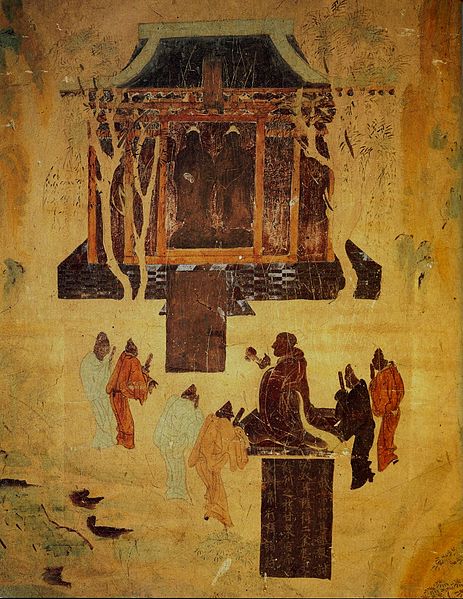File:HanWudiBuddhas.jpg

Original file (1,543 × 1,996 pixels, file size: 2.34 MB, MIME type: image/jpeg)
Captions
Captions
Summary
[edit]| DescriptionHanWudiBuddhas.jpg |
English: 8th century fresco at Mogao Caves near Dunhuang in Gansu Province. Depiction of the Han Emperor Wu worshiping statues of the Buddha. Attached textual description of Han Wudi worshiping golden men brought in 120 BC by a great Han general in his campaigns against the nomads:
"Emperor Han Wudi directed his troops to fight the Xiongnu and obtained two golden statues about 1 zhang tall [3 meters] that he displayed in the Ganquan Palace and regularly worshipped." The frescoe is located in Cave 323 in Mogao. It pertains to the same panel showing the departure of Zhang Qian to Western lands (Image:ZhangQianTravels.jpg). The two paintings are side-by-side. It combined legend and historical fact. It has been argued that the statue is a three meters colossal Zeus holding a goddess as no statues of the Buddha existed prior to the Indo-Greeks.[1]中文:漢武帝將其部眾討凶奴,並獲得二金(人),(各)長丈餘,刊〔列〕之於甘泉宮,帝(以)為大神,常行拜褐時。 |
| Date |
8th century date QS:P,+750-00-00T00:00:00Z/7 |
| Source | Reproduction in Roderick Whitfield, Susan Whitfield, Neville Agnew, and Lois Conner, Cave Temples of Mogao: Art and History on the Silk Road. Getty Conservation Institute and the J. Paul Getty Museum, 2000: p.19. ISBN 978-0-89236-585-2 |
| Author | Unknown authorUnknown author |
- 13:34, 12 May 2005 . . User:PHG . . 643×974 (592,563 bytes) (8th century fresco at Mogao Caves near Dunhuang in the Tarim Basin. Depiction of Han Emperor Wu worshiping statues of the Buddha. PD-art )
Licensing
[edit]|
This is a faithful photographic reproduction of a two-dimensional, public domain work of art. The work of art itself is in the public domain for the following reason:
The official position taken by the Wikimedia Foundation is that "faithful reproductions of two-dimensional public domain works of art are public domain".
This photographic reproduction is therefore also considered to be in the public domain in the United States. In other jurisdictions, re-use of this content may be restricted; see Reuse of PD-Art photographs for details. | |||||
- ↑ Lucas Christopoulos; Dionysian rituals and the Golden Zeus of China http://www.sino-platonic.org/complete/spp326_dionysian_rituals_china.pdf pp.72-74.
File history
Click on a date/time to view the file as it appeared at that time.
| Date/Time | Thumbnail | Dimensions | User | Comment | |
|---|---|---|---|---|---|
| current | 23:59, 30 October 2010 |  | 1,543 × 1,996 (2.34 MB) | Eugene a (talk | contribs) | Large |
| 09:00, 15 August 2006 |  | 643 × 974 (579 KB) | Jonathan Groß (talk | contribs) | {{Information |Description=8th century frescoe at Mogao Caves near Dunhuang in the Tarim Basin. Depiction of Emperor Han Wudi worshipping statues of the Buddha. Attached textual description of "Han Wudi" worshiping "golden men brought in 120 BC by a great |
You cannot overwrite this file.
File usage on Commons
The following page uses this file:
File usage on other wikis
The following other wikis use this file:
- Usage on az.wikipedia.org
- Usage on ba.wikipedia.org
- Usage on be.wikipedia.org
- Usage on bg.wikipedia.org
- Usage on bn.wikipedia.org
- Usage on bo.wikipedia.org
- Usage on ca.wikipedia.org
- Usage on cs.wikipedia.org
- Usage on da.wikipedia.org
- Usage on en.wikipedia.org
- Usage on en.wikibooks.org
- Usage on es.wikipedia.org
- Usage on fr.wikipedia.org
- Usage on hu.wikipedia.org
- Usage on id.wikipedia.org
- Usage on it.wikipedia.org
- Usage on ja.wikipedia.org
- Usage on kk.wikipedia.org
- Usage on ko.wikipedia.org
- Usage on nl.wikipedia.org
- Usage on no.wikipedia.org
- Usage on pam.wikipedia.org
- Usage on pl.wikipedia.org
- Usage on pt.wikipedia.org
- Usage on ru.wikipedia.org
View more global usage of this file.
Metadata
This file contains additional information such as Exif metadata which may have been added by the digital camera, scanner, or software program used to create or digitize it. If the file has been modified from its original state, some details such as the timestamp may not fully reflect those of the original file. The timestamp is only as accurate as the clock in the camera, and it may be completely wrong.
| Camera manufacturer | HP |
|---|---|
| Camera model | HP Scanjet G3010 |
| Date and time of data generation | 03:36, 10 August 2008 |
| Y and C positioning | Co-sited |
| Exif version | 2.2 |
| Color space | sRGB |
| Saturation | Normal |
| Sharpness | Normal |